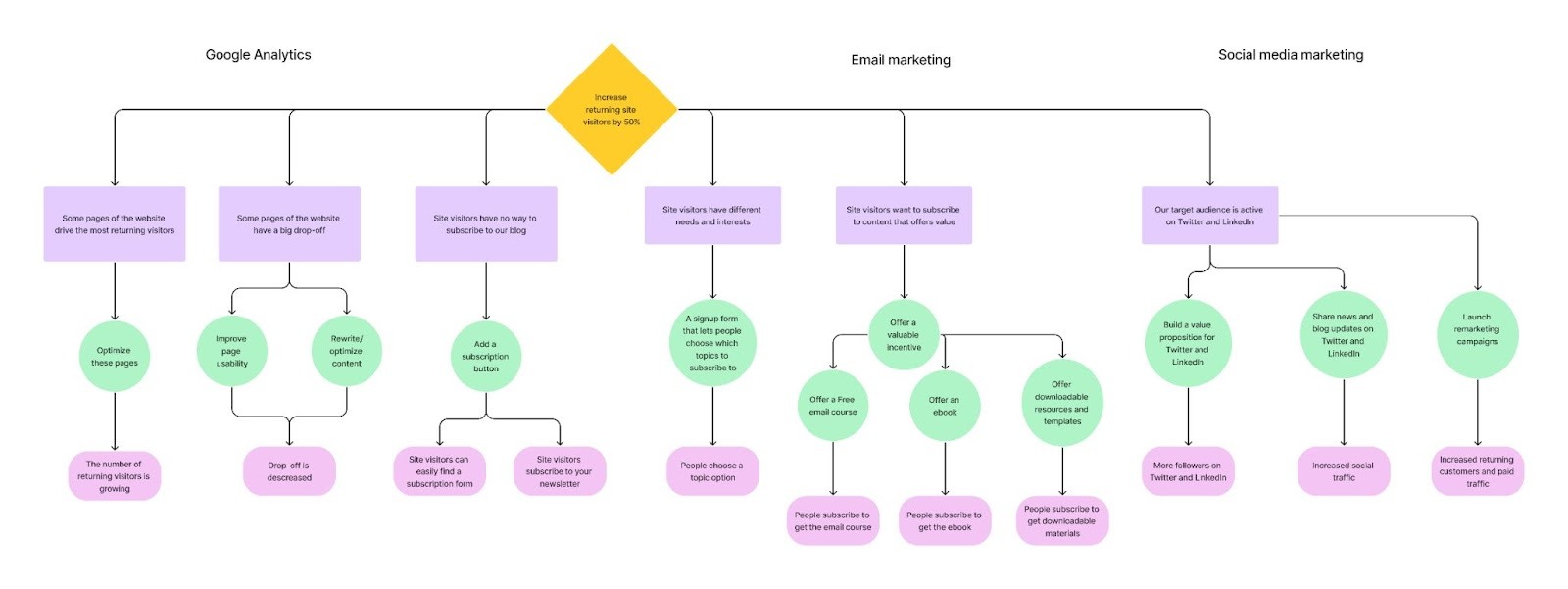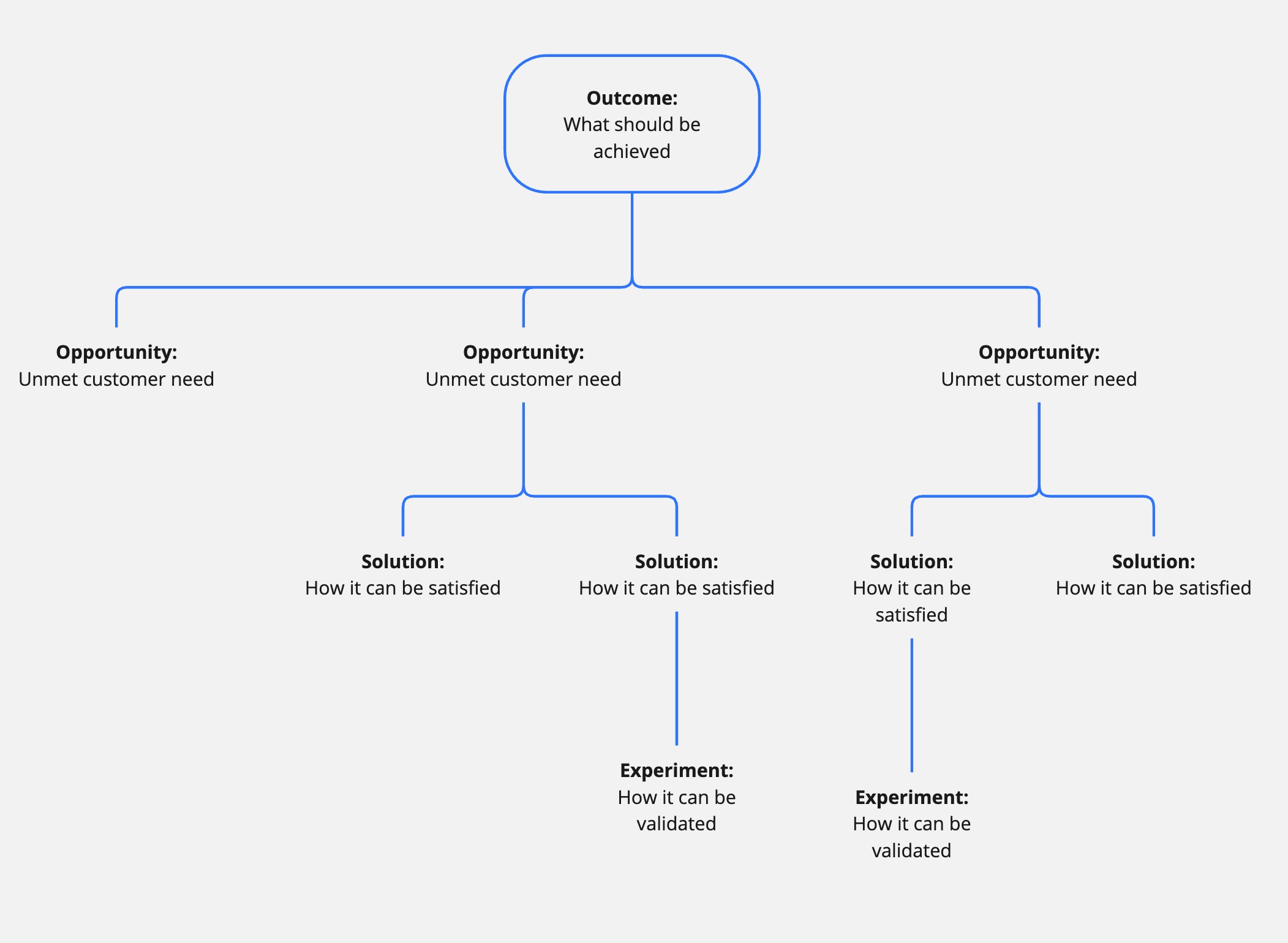I love mental frameworks for building strategy.
They make your brain cells actually function. Instead of staring at a blank page wondering where to start or asking ChatGPT to do it for you, frameworks force you to think.
The whiteboard is the best tool for this. Drawing boxes and arrows, crossing things out – that's when strategy happens.
Today I'm sharing one framework that changed how I approach content decisions: the Opportunity Solution Tree (OST).
Teresa Torres created it for product teams in her book Continuous Discovery Habits. But it works beautifully for marketing too.
Think of it as a map for your content strategy. It helps you visualize all possible paths, plan your experiments, and test your assumptions before committing resources.
In today's newsletter:
Watch it instead:
Someone says "we need more leads" and immediately everyone starts shouting solutions:
"Launch a webinar series!"
"Write more SEO content!"
"Start a podcast!"
But nobody stops to ask: What's the actual opportunity here? What problem are we solving? How will we know if it works? That's where the OST comes in.
Here is how Opportunity Solution Tree works.
Don't just set a vague goal. Define exactly what success looks like and how you'll measure it.
Not "increase engagement" → "Double monthly recurring revenue," "Generate 10X qualified leads," or "Increase returning visitors by 50%."
Research your customers. What problems might bring them back? What gaps exist in their journey? List every opportunity that could potentially impact your metric.
For each opportunity, brainstorm solutions that could address it. These are hypotheses worth testing to see if they move your metric.
Every solution is built on assumptions. Design small experiments to validate or invalidate each assumption before scaling up.

Returning visitors are significantly more likely to convert than first-time visitors, yet most content teams spend 95% of their effort chasing new traffic. Let me walk you through how you could use OST to approach the returning visitor challenge.
Desired outcome: Increase returning site visitors by 50%
The opportunity to explore: Some pages might already be driving more returning visitors than others. What if we could identify and optimize these pages?
Hypothesis to test: If certain pages naturally attract returning visitors, enhancing these pages could amplify their effect.
Assumptions to validate:
How to test:

Three opportunities worth exploring:
1. Subscription visibility
2. Personalized content delivery
3. Value exchange
The opportunity: Your audience might be active on social platforms where you're not present.
Hypothesis 1: Platform-specific value
Hypothesis 2: Content distribution
Hypothesis 3: Remarketing
Look at the opportunity solution tree we've just created:

Here's a Miro template for your Opportunity Solution Tree:

When you build your OST alone, you get one perspective. When you do it with your team, you get multiple viewpoints on opportunities and diverse solutions. So set aside 2 hours for a team session. Map out opportunities together, generate hypotheses, and prioritize which assumptions to test first.
Returning visitors is just one example. You could map:
Pick your outcome. Research your opportunities. Map solutions. Test assumptions.
Your next step:
Pick one metric that matters most right now. Identify three opportunities that could impact it. Design one small experiment to test your first assumption this week.
Before you go, make sure you also check out my article about how to use the Issue Tree to find and solve problems in your content strategy.
Both the issue tree and the Opportunity Solution Tree are two useful tools in your content strategy toolbox. The Issue Tree helps you turn complex problems into manageable pieces and the Opportunity Solution Tree helps you develop a mental representation of desired outcomes and plan the ways to reach them.
Have you built a content strategy for 2026 yet?
Kateryna
P.S. If we aren't connected already, follow me on LinkedIn and Instagram. If you like this newsletter, please refer your friends.
P.P.S. Need help with quality content? Zmistify your content with Zmist & Copy


If you want to generate leads, your content needs to correspond to the right stage of the customer's journey. Learn how you can build your content strategy using 5 Stages of Awareness. I break down the whole process into 5 easy steps.
Subscribe to From Reads to Leads for real-life stories, marketing wisdom, and career advice delivered to your inbox every Friday.